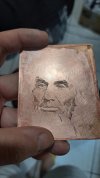Engraver10
Member
Hello Forum friends,
some time ago, I asked here how to prevent my copper plate from oxidizing. I'm practicing Intaglio, and the process takes a long time, so in a few days the plate is all stained.
I spoke to a great master engraver and he recommended cleaning my hands with alcohol before starting engraving. His tip helped a little. But the plate still oxidized, I tried to apply a thin layer of Lubricating Spray to create a small protective film, but when I went to work on the engraving, I removed the oil with absorbent paper.
But when I realized the transferred drawing was gradually being erased, I believe that the Spray acted like a solvent. Could a friend help me with some tips to avoid oxidizing the copper plate.
Thank you very much, any help will be welcome.
Best Regards
some time ago, I asked here how to prevent my copper plate from oxidizing. I'm practicing Intaglio, and the process takes a long time, so in a few days the plate is all stained.
I spoke to a great master engraver and he recommended cleaning my hands with alcohol before starting engraving. His tip helped a little. But the plate still oxidized, I tried to apply a thin layer of Lubricating Spray to create a small protective film, but when I went to work on the engraving, I removed the oil with absorbent paper.
But when I realized the transferred drawing was gradually being erased, I believe that the Spray acted like a solvent. Could a friend help me with some tips to avoid oxidizing the copper plate.
Thank you very much, any help will be welcome.
Best Regards








